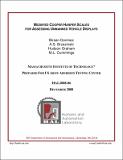Modified Cooper Harper Scales for Assessing Unmanned Vehicle Displays
Author(s)
Graham, Hudson; Cummings, M. L.; Donmez, Birsen; Brzezinski, A. S.
DownloadHAL2008-06.pdf (7.140Mb)
Other Contributors
Massachusetts Institute of Technology. Dept. of Aeronautics and Astronautics. Humans and Automation Laboratory
Metadata
Show full item recordAbstract
In unmanned vehicle (UV) operations, displays are often the only information link between
operators and vehicles. It is essential these displays present information clearly and efficiently so that
operators can interact with the UVs to achieve mission objectives. While there are a variety of metrics to
evaluate displays, there is no current standardized methodology for operators to subjectively assess a
display’s support and identify specific deficiencies. Such a methodology could improve current displays
and ensure that displays under development support operator processes. This report presents a quasi-
subjective display evaluation tool called the Modified Cooper-Harper for Unmanned Vehicle Displays
(MCH-UVD) diagnosis tool. This tool, adapted from the Cooper-Harper aircraft handling scale, allows
operators to assess a display, translating their judgments on potential display shortcomings into a number
corresponding to a particular deficiency in operator support. The General MCH-UVD can be used to
diagnose deficiencies for any UV display, while the Specific MCH-UVD is UV and mission specific in its
evaluation of displays. This report presents the General MCH-UVD and provides guidance on how to
adapt it to create a Specific MCH-UVD through the use of UV mission taxonomies and a questioning
method. A UGV search mission case study provides a how-to guide example for generating a Specific
MCH-UVD. The report also presents an experiment conducted to validate the MCH-UVD and assess if a
mission-specific version is necessary, or if the general form of the MCH-UVD is sufficient for different UV
display evaluation. The report concludes with discussion on how to administer the scale, when a Specific
scale is necessary, MCH-UVD diagnosis tool limitations, and future work.
Date issued
2008Publisher
MIT Humans and Automation Laboratory
Series/Report no.
HAL Reports;HAL2008-06